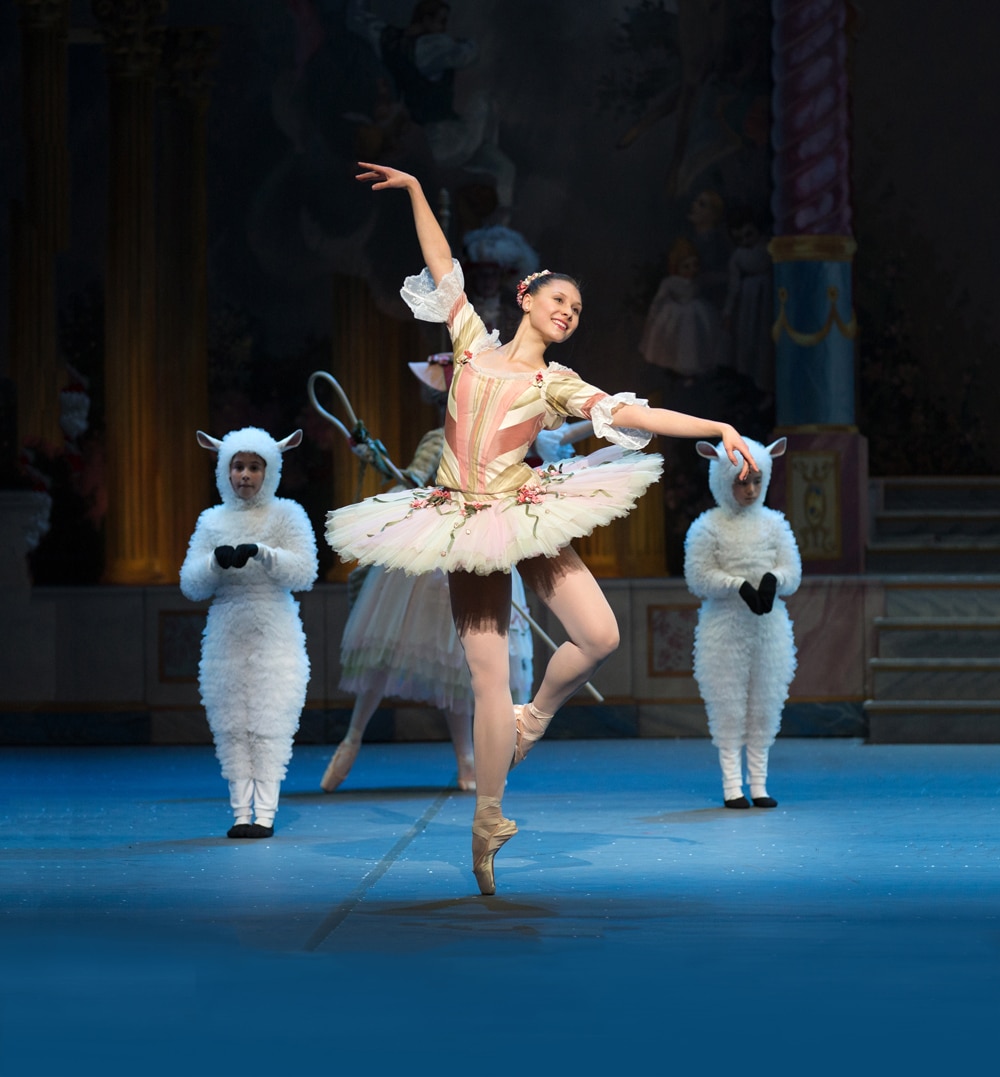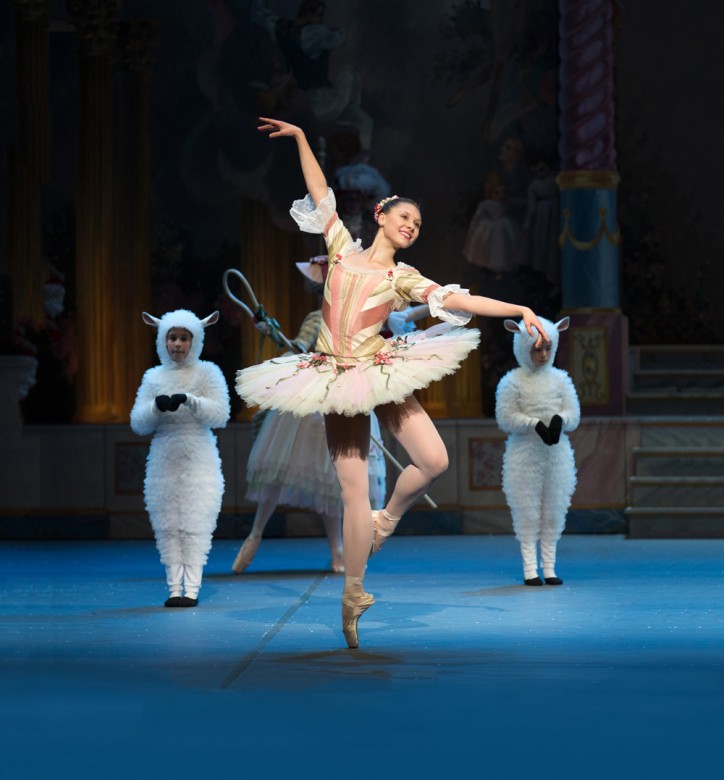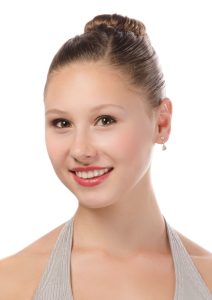A Dancer’s Life | The Yankee Interview
In his new book, Vanishing Vermonters, writer and photographer Peter Miller both honors Vermont and captures a side of his home state he fears we may be losing.

Lauren Herfindahl in Mikko Nissinen’s The Nutcracker.
Photo Credit : Rosalie O’Connor, courtesy of Boston Ballet.
Photo Credit : Rosalie O’Connor, courtesy of Boston Ballet.
Yankee: First of all, what is a second soloist?

Photo Credit : Liza Voll, courtesy Boston Ballet
Within the company, there are different ranks of dancers. “Principal dancer” is the highest, and they do all of the big, principal solo roles. The rank below that, the soloists, do soloist and principal roles. Below that is the second soloist. I do soloist roles as well as corps de ballet roles. The corps de ballet is all the ensemble dancers.
What’s the difference between a soloist role and a principal role?
In The Nutcracker, principal roles are Snow Queen, the Sugarplum Fairy, the Dewdrop Fairy, and the Arabian dancers. Ballet hierarchy is very interesting, because someone from the corps de ballet can do a principal role, but a principal dancer cannot do a corps de ballet role.
So you can go up, but you can’t go down.
Exactly.
How long have you been dancing with Boston Ballet?
I’m finishing up my sixth season. I was in Boston Ballet II, the apprentice company, for two seasons, and I was in the corps de ballet for three and a half seasons, and in January I was promoted to second soloist.
But you’ve actually danced with the company for much longer than that.
Yes. My first role in The Nutcracker was in 2005, when I was 10. I was a mouse and a polichinelle [little clown]. In the second act, in the Land of Sweets, there’s a dance between Mother Ginger and her children. It’s a man who plays the part [of Mother Ginger], and he walks out on stilts in a big dress, and all these little kids run out from under his dress and do a little dance with Clara and Drosselmeyer — those are the polichinelles.
What do you remember from that time?
I have a very vivid memory of one of my firstNutcrackerperformances, as a mouse. The battle scene then was quite different. At the very beginning, when Clara falls asleep under the tree with the nutcracker, one little kid comes out in a mouse costume and does a little solo. And I was that little mouse. I was only 10, and standing there all by myself in the wings in this mouse costume and a full-head mask thing that you couldn’t really see out of. The whole time I’m thinking, No one’s going to tell me when to go on. This is all me. I have to take control of this and know what I am supposed to do.It’s pretty incredible to have that responsibility put on you.
How long have you been dancing?
I’ve been dancing since I was about 2 or 3. I would dance around the house all day when I was young and would put on little shows for family and friends when they would come over. So my mom finally said, all right, I have to put this girl in a dance class of some sort, and it just so happened it was ballet.
Your family moved to the Boston area when you were 8, which is when you began studying with Boston Ballet. What’s it been like for you growing up in this company?
It’s been so great! I performed almost every single child role inThe Nutcracker: mouse, party girl, polichinelle. I was Clara one year. And as I got older, I was tea, which is one of the student roles, then a shepherdess, and a Sugarplum Fairy attendant. But it’s also not just aboutThe Nutcracker.
Because the ballet often uses younger dancers in its other productions, right?
Yes. When you’re in Boston Ballet School, you have to not only be able to perform well with the company but also to improve. I performed inA Midsummer Night’s Dream, La Sylphide, Don Quixote. My first role ever with the ballet was as a page inThe Sleeping Beauty. We did that earlier this year, and I was one of the fairies, so it’s kind of cool to come full circle on that one. It is really crazy to look at the kids playing the pages now and think that I was one of those little kids 12 years ago.
When did you know that dancing was what you wanted to do for a profession, not just for fun?
I think I made the decision when I was about 12. You’re right. There’s a period of “This is cute, I’m dancing with my friends, it’s fun.” But if you want to make this a profession, you really do have to make that decision at a young age. I started training during the day when I was 14, after I was offered an opportunity to move into the trainee level with Boston Ballet School. That’s the highest level in the school, with a technique class, pointe and variations classes, partnering, Pilates, even character classes. Trainees understudy and sometimes perform company roles in the corps de ballet. Becoming a trainee was a big stepping stone to getting a professional company contract. Since I don’t ever remember a time when I didn’t want to dance, transitioning into more intense training was natural, and it excited me because I knew it was one step closer to fulfilling my dream.
It sounds like you may have missed out on a typical teenager’s life.
I went to high school online. I definitely had to give up things from normal childhood, like going to prom and hanging out with out friends on the weekend. I remember spending all day in the studio on Saturdays and sometimes on Sundays as well, taking extra classes and working in extra performance groups. But I don’t feel like I was missing out on anything, because I loved what I was doing so much. I don’t think there was a tradeoff — or if there was, I definitely got the better end of the deal.
What’s a typical day like?
I usually get to the studio about 9 in the morning. Every day, we have a 90-minute technique class. Even when we are performing, we have a technique class. It’s kind of like breakfast for the body. It’s a way to tune yourself into how you’re feeling for the day, to improve certain skills that you’re going to be using in upcoming performances and just keep yourself in shape. Some days I have two or three hours of rehearsal; other days I have five or six. On days when we have one show in the evening, we usually have class in the morning, three hours of rehearsal, and a break before the show. On two-show days, we have a morning class, a show, then a break and the show in the evening.
Not exactly a relaxing lifestyle.
[Laughs.] Not at all. On top of rehearsal hours and class, I usually spend about an hour a day doing cross training or cardio or physical therapy exercises. I do cardio workouts to increase my stamina, and I work with our physical therapists to address any current pain or injuries as well as to create an exercise routine that helps strengthen any muscle weaknesses that could make me more injury-prone or slow the recovery of a current ailment. Sometimes I get home at the end of the day and I can’t stand to make my dinner. I just have to sit down because my legs and feet are aching after a long day of rehearsal. On days when I feel exhausted, I just make sure to take some extra time to help my body recover. I might do contrast buckets for my lower legs, which is one bucket of hot water and Epsom salt and another of ice water, or use foam rollers to roll my sore muscles.
Do you have a favorite role in The Nutcracker? And what other roles are you hoping to play in your career?
Last season I was the Dewdrop Fairy. That was very exciting. I love that part. It’s so technically challenging. I’d love to dance Odile inSwan Lake. That is one of the hardest roles in ballet you can do, so that’s always been on my list. Then there are pieces by composer George Balanchine. My favorite ballet of his isDiamonds. I’ve performed in his works in the corps roles but I’d love to take on a principal role.
If you had to pick one word to describe your dance career, what would it be?
Joy. I love performing. Despite all the challenges that dancing requires you to overcome, and all the hard work, I do it because I love it and because it brings me joy. And I hope it makes the audience feel the same way.


